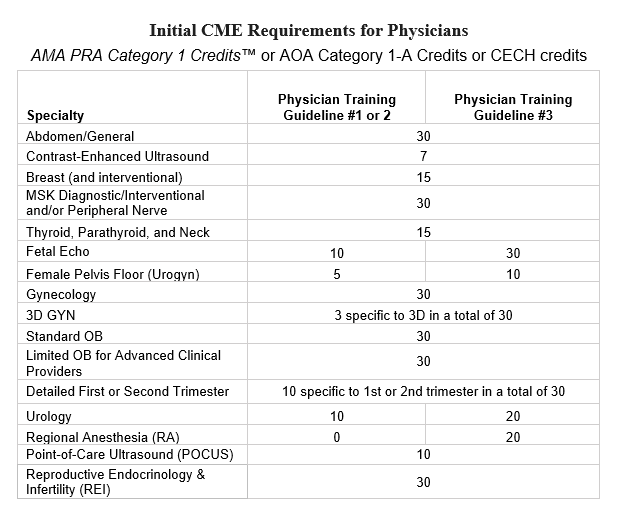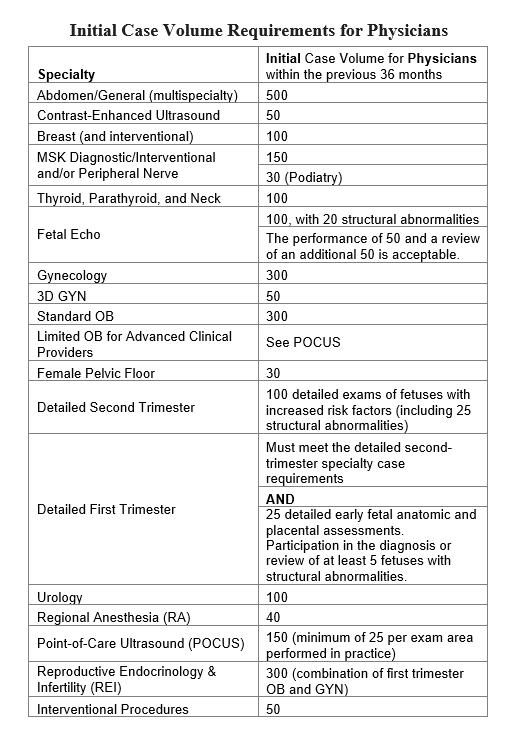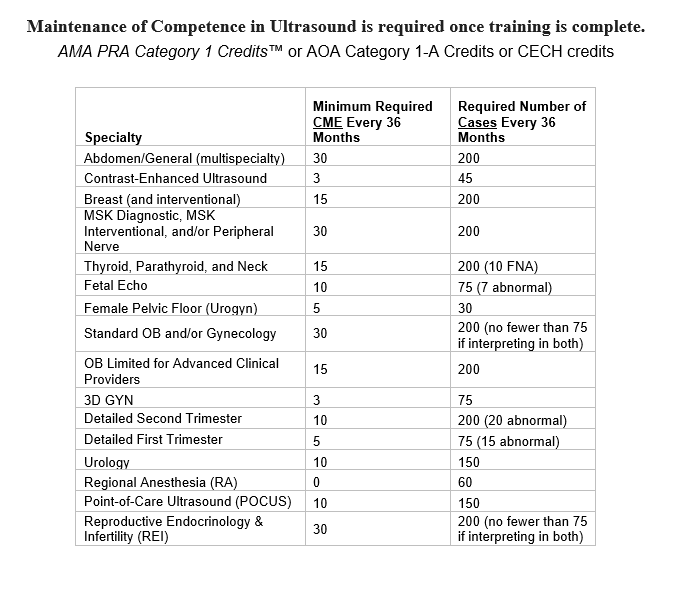Training Guidelines for Physicians Who Perform and/or Interpret Diagnostic Ultrasound Examinations
Mar 29, 2025
The physician must have an active medical license and demonstrate competence in the performance and interpretation of diagnostic ultrasound examinations in the area of their practice.
This competence encompasses but is not limited to the following*:
1. A thorough understanding of indications, limitations, and guidelines of diagnostic ultrasound examinations.
2. Familiarity with alternative and complementary imaging and diagnostic procedures, including the ability to correlate results with ultrasound findings.
3. Knowledge of the basic physical principles of ultrasound, including power output and adherence to the ALARA principle, patient and operator safety, and recommendations for quality assurance of ultrasound equipment.
4. Demonstrate a thorough understanding of the anatomy, physiology, and pathophysiology of those organs being examined, providing the knowledge and experience to differentiate between normal and abnormal findings.
5. Training experience must be based on the ability to analyze a full set of images, which comprises the entire examination to determine completeness and image quality to render a clinically appropriate diagnostic interpretation.
6. The training must include methods of documentation and reporting of ultrasound studies.
Pathways to Demonstrate Competence:
Physicians performing and/or interpreting diagnostic ultrasound examinations should meet at least one of the following pathways (1–3) AND have met the AIUM case volume experience requirement as outlined in initial training.
1. Specialty Board Eligibility or Certification in the relevant area of practice such as:
a. American Board of Radiology (ABR), American Osteopathic Board of Radiology, The Royal College of Physicians and Surgeons of Canada, or Le Collège des Médecins du Québec certification in Diagnostic Radiology or Interventional Radiology.
b. American Board of Obstetrics and Gynecology (ABOG) or American Osteopathic Board of Obstetrics and Gynecology (AOBOG) certification for specialty certification in Obstetrics & Gynecology.
c. American Board of Emergency Medicine (ABEM) certification in Emergency Ultrasound or Focused Practice Designation in Advanced Emergency Medicine Ultrasonography by ABEM or Area of Focused Competence Designation for Acute Care Point of Care Ultrasound by the Royal College of Physicians and Surgeons of Canada (demonstrates training in point-of-care ultrasound).
d. American Board of Urology.
e. American Board of Anesthesiology certification in Ultrasound Guidance in Regional Anesthesia.
2. Subspecialty Board Certification OR Focal Ultrasound Certification in the relevant area of practice such as:
a. Maternal-Fetal Medicine (MFM) certification.
b. Reproductive Endocrinology & Infertility certification.
c. Female Pelvic Medicine and Reconstructive Surgery certification.
d. American Board of Pediatrics-subspecialty Pediatric Cardiology.
e. American Society of Breast Surgeons certification in Breast Ultrasound.
f. Sports Medicine subspecialty board certification by the American Board of Emergency Medicine (ABEM) or the American Board of Pediatrics (ABP).
g. American Board of Family Medicine (ABFM), American Board of Internal Medicine (ABIM), American Board of Physical Medicine and Rehab (ABPMR).
h. RhMSUS™ certification.
i. Credentialing in ultrasound by the Alliance for Physician Certification & Advancement (APCA).
For each pathway (1-2):
If Board related training or certification with specific ultrasound education was completed over 36 months ago, the physician must provide documentation of the following:
a. AMA PRA Category 1 Credits™ or AOA Category 1-A Credit or CECH credits, which are ultrasound-specific and relevant to the area of practice. Physicians interpreting in multiple specialty areas must provide a representative sample of CME credits (no less than 5 CME credits in any one area. It is not necessary to exceed 30 credits), reflecting their areas of practice.
AND
b. Meeting the case volume in accordance with the AIUM maintenance of competence (MOC) for the relevant specialty.
3. Case-by-Case Consideration: Physicians who are Board Eligible or Board Certified by an ACGME-approved residency and/or fellowship or CPME-recognized specialty certifying board but did NOT have specialty-specific ultrasound training may be considered based on their clinical experience.
To be considered, physicians must:
a. Demonstrate completion of the required initial number of AMA PRA Category 1 Credits™ or AOA Category 1-A or CECH credits, defined by the AIUM's initial CME requirements, within the previous 36 months; these credits must be ultrasound-specific and relevant to the area of expertise (we encourage including the completion of hands-on courses).
AND
b. Evidence of performing, interpreting, and reporting ultrasound examinations within the previous 36 months, meeting the AIUM's initial case volume requirements for their specialty; the required case volume should be obtained under the supervision or support of a physician who meets the requirements outlined in the above pathway, either directly or remotely.
OR
c. Documentation of Training and Experience: If the physician has been performing, interpreting, and reporting ultrasound for an extended period of time independently, they can document their qualifications, including CME and volumetric experience, in an affidavit to the AIUM Ultrasound Practice Accreditation Council for personalized review.
* For accreditation purposes, international training programs that are equivalent in scope and rigor to these guidelines may be accepted upon review by the AIUM Ultrasound Practice Accreditation Committee (UPAC).



